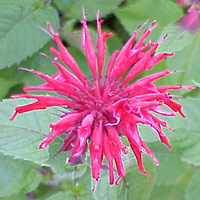Bee Balm

Bee balm flowers are brilliant additions to late-summer herb gardens and flower borders. Butterflies, hummingbirds, bees, and other nectar-seeking creatures covet the tubular flowers on the plant's rounded flower heads, and the leaves and flowers can also be made into tea. Other common names include horsemint, wild bergamot, and Oswego tea.
About This Plant
Bee balm flower colors include pink, red, and white; new double-flowered forms are also available. The plant blooms from early to late summer and grows 2 to 4 feet tall, depending on the variety. Some bee balm species tolerate wet soil and will thrive along a waterway or in a bog garden. Bee balm is susceptible to powdery mildew disease, so select resistant varieties. Under favorable growing conditions the plant can become invasive.
Special Features
Easy care/low maintenance
Multiplies readily
Attracts hummingbirds
Attracts butterflies
Tolerates wet soil
Site Selection
Select a site with full sun to light shade and rich, well-drained soil. Some species tolerate wet soils, while others are adaptable to a wide range of soil moisture levels.
Planting Instructions
Plant in spring or fall, spacing plants 1 to 2 feet apart. Prepare garden bed by using a garden fork or tiller to loosen soil to a depth of 12 to 15 inches, then mix in a 2- to 4-inch layer of compost. Dig a hole twice the diameter of the plant's container. Carefully remove the plant from its pot and place it in the hole so the top of the rootball is level with the soil surface. Carefully fill in around the rootball and firm the soil gently. Water thoroughly.
Care
Apply a thin layer of compost each spring, followed by a 2-inch layer of mulch to retain moisture and control weeds. Water plants during the summer if rainfall is less than 1 inch per week. Remove spent flowers to keep plants looking tidy. After the first killing frost, cut stems back to an inch or two above soil line. Divide plants in spring every few years or when you notice the center of the plant dying out.






 Bee balm flowers are brilliant additions to late-summer herb gardens and flower borders. Butterflies, hummingbirds, bees, and other nectar-seeking creatures covet the tubular flowers on the plant's rounded flower heads, and the leaves and flowers can also be made into tea. Other common names include horsemint, wild bergamot, and Oswego tea.
Bee balm flowers are brilliant additions to late-summer herb gardens and flower borders. Butterflies, hummingbirds, bees, and other nectar-seeking creatures covet the tubular flowers on the plant's rounded flower heads, and the leaves and flowers can also be made into tea. Other common names include horsemint, wild bergamot, and Oswego tea.